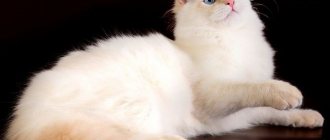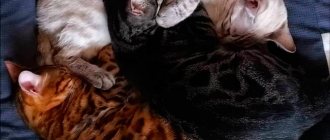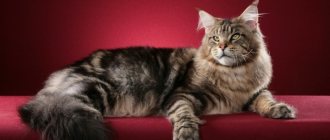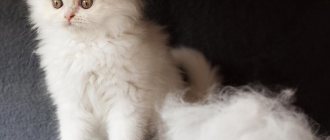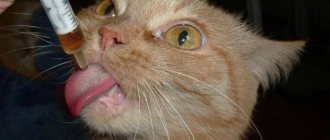Home » Cat Breeds
According to an ancient legend composed by the Arab people, desert cats appeared when a lion sneezed. Indeed, in grace, stature and temperament, Mau are very reminiscent of small lions. Formed in difficult conditions, the Mau learned to survive without humans. But this did not make them less sociable and loyal.
- 2 Standard
2.1 Photo gallery: colors of Arabian Mau
- 3.1 Video: Arabian Mau
- 4.1 Features of feeding natural food
4.2.1 Photo gallery: food for the Arabian Mau
- 4.3.1 Photo gallery: devices and means for caring for the Arabian Mau
- 4.4.1 Photo gallery: caring for the Arabian Mau
History of the Arabian Mau
The Arabian Mau is one of the oldest indigenous breeds in the world. For more than 1000 years, there have been cats that became their direct ancestors - desert steppe cats. Desert cats have lived on the territory of the Arabian Peninsula for a long time, and after the first settlements appeared on its territory, cats moved closer to people - this made it easier for them to get food.
Arabian Mau - desert cats of the Arabian Peninsula
Until 2004, Arabian beauties remained simple street cats of Arabia. But everything changed when their natural beauty was noticed by Petra Muller, the head of one of the felinological clubs in the UAE. Under her leadership, the selection of cats began. After 4 generations, which produced 18 heads of ideal, according to Muller, cats, a standard was sent to the WCF, which was adopted in 2008. Other organizations have not yet recognized the desert beauties.
History of the origin of Arabian cats
For a thousand years, according to the history of the Arab countries, proud and hardy desert cats lived on the Arabian Peninsula. They existed in difficult natural conditions, mainly leading a nocturnal lifestyle, because in the desert temperatures acceptable for hunting are set closer to the night time. After many years, the ancient Arabs gradually began to domesticate them.
These animals were distinguished by such qualities as resistance to the scorching sun and difficult living conditions. They were also valuable for their hunting qualities. Soon, desert representatives of the feline world began to be found more often near the cities of the Middle East, since it is much easier to find food near human settlements. Desert cats soon began to be found in the Persian Gulf countries. However, residents of Arab countries were in no hurry to welcome such a pet into every home, as cats “from overseas” were becoming popular.
For a long time, local cats were simply not noticed, and foreign ones were still welcomed with cordiality. More recently, the Arabian cat was appreciated. MECATS UAE President Petra Muller was the first to pay tribute to the natural grace and gentle disposition of the animal in 2004. She showed sensitivity and interest in the feline inhabitants of the streets. Since that time, breeders began to be interested in breeding the desert cat. A few years later, in 2008, there were already four generations of animals in the world, totaling 18 pets. The breed was named after its primary habitat and historical homeland - Arabian Mau . During the same period of time, it was recognized by the WCF organization and a standard was developed for it.
Currently, there are more representatives of the Arabian breed, as the popularity of the animal is steadily growing. Breeders are actively breeding Arabian Mau.
Standard
The Arabian Mau is a medium-sized cat that can reach around 4–8 kg. The standard defines the following characteristics for the Arabian Mau:
- General appearance: a strong, well-built cat with an elongated muscular body, graceful, not too thin and not too heavy in build. Hips slightly wider than shoulders.
- Legs: High and long, with strong bones and noticeable muscles. The feet are small and oval in shape. The hind legs are slightly longer than the front ones.
- Tail: Medium length, tapering to a tip, flexible and well feathered. There should be no kinks or knots on the tail.
- Head:
- it seems almost round, but in fact its length is greater than its width;
- whisker pads are voluminous and dense;
- curved profile with prominent chin;
- the nose is neat, small, triangular in shape;
- cheekbones are high and emphasized;
- The eyes are oval-shaped, small, widely set. Their color should be in harmony with the color of the coat; they are usually green and yellow;
- The Arabian Mau's ears are small, with pointed tips topped with small tufts. The fit is neither high nor low, the outer contour of the ear continues the line of the muzzle. The ears are slightly tilted in opposite directions from each other;
- Wool:
- adjacent to the body, silky, smooth and shiny;
- in adult cats, it can become coarser with age and always adheres to the body, without hiding its contours and shapes;
- There should be no undercoat.
- Colors:
- red and red tabby (tabby patterns: mackerel, spotted);
- red with any amount of white (van, harlequin, bicolor, with white spots, etc.);
- black with any amount of white;
- silver tabby (tabby pattern: mackerel, spotted);
- black solid (clean, deep black, shiny, without a hint of tint, without scorching or rust);
- white solid (ideal snow-white, without shades or patterns);
- brown and brown tabby (can be with white, tabby pattern: spotted, mackerel);
- in all tabby colors the tabby pattern extends throughout the body;
- calico, lightened calico, tortie and these colors with any amount of white.
Photo gallery: Arabian Mau colors
The silver tabby color may have spots and stripes.
The red color is bright and eye-catching
There should be no markings in the black color
No more than three spots are allowed in a van's color.
Brown tabby is the most common color in cats.
The brown tabby bicolor is called piebald.
Silver tabby bicolor is a rather rare color
Black bicolor looks like a business suit
Bleached calico with white - unusual color
Cats of the Calico Van color are also found among Arabian Mau
External characteristics of an adult
The exterior of the Mau is not distinguished by outstanding characteristics, however, they are quite attractive short-haired cats that look very cute and get along well in any conditions. The appearance of a cat has been formed over thousands of years and is designed to survive in the most difficult natural conditions.
Maximum height
These cats are not small, they have long, slender limbs and a muscular, slightly elongated body. They look larger than ordinary pets due to their trained, flexible body.
Weight
The heaviness of the animal depends on the conditions of detention and gender. In particular:
- males weigh about 7 – 8 kg;
- females – approximately 4 – 6 kg.
They are quite large and have a powerful build.
Features of color
The colors of wild cats from the Arabian Peninsula are very diverse. Most likely this is due to uncontrolled matings between domestic pets and wild aboriginal cats. However, experts identify the most common coat color as red with white spots.
There are also brown, grey, snow-white, anthracite-black, red, tabby, tortie or bicolor shades. There can be a lot of color options. Experts evaluate each individual representative of the breed in their own way.
Ears, tail
The cat's ears are quite large, widely spaced on the head, have edges on the inside and outside, and the tips are narrowed and rounded. The tail of a wild cat is proportional to the body, thick at the base, and tapering strongly towards the tip.
Character and behavioral characteristics
The main feature of the character of the Arabian Mau, like all aboriginal breeds, is attachment to the “pack,” that is, the family, and the “leader,” that is, the owner. Mau are ready to zealously, like dogs, protect their household from everything that seems dangerous to them. Despite such fanatical devotion, Mau show themselves to be quite independent and proud cats, which does not prevent them from basking on their owner’s lap from time to time.
The origin of the Mau left a considerable imprint on his character. These cats are natural hunters and excellent mousecatchers. Moreover, they bring all their prey to the “flock,” which may not please squeamish and sensitive people. By nature, Mau are unusually active. If you do not give them the necessary physical activity, they can create an unimaginable mess in the apartment.
Mau is very attached to his owner
Mau are explorers. They will not leave a single corner of their territory without their attention. They can easily climb the tallest cabinets. The owner of the Mau should be concerned about his safety: the fearless cat will jump from the tenth floor without hesitation. Therefore, if you live in an apartment, there should be protection on the windows.
Another feature of the Mau is the need for personal space. The more there is, the happier the Mau. The ideal home for such cats is a spacious country house with a garden plot. Mau cats are much more active at night. But if you take a small kitten into your home, over time it will adapt to the daytime routine.
In nature, Mau are nocturnal
Mau are one of those cats that are not afraid to be allowed to roam freely. Noble desert beauties will never allow themselves to get involved in a fight, they will behave prudently and carefully. They will never get lost on the way home thanks to their unusually developed sense of smell, ability to navigate in space and memory. But still, with such free walks, even one cat is not immune from danger (dogs, people who are cruel to animals, etc.). Therefore, if you are afraid to let your pet out alone, do not be lazy to walk him on a leash. Mau once every two days is enough for a comfortable life.
Mau have an excellent memory
Also, the Mau will not bother busy people. These self-sufficient cats feel equally at home both in a large noisy family and in the company of a lonely, busy person. They tolerate loneliness very well. The main thing is that they have something to do and play with, since the worst thing for Mau is boredom.
As for his attitude towards children, everything depends only on them. Mau will only get along with the child who respects him. It is unacceptable to pull a Mau by the tail, ruffle his ears, and even more so obsessively follow him, caress him against his will and force him to do anything. The first time, the Mau will limit himself to a warning hiss, and the next time, without a twinge of conscience, he will use his claws and teeth. Therefore, it is not recommended to adopt an Arabian cat into a family with children under 10 years of age. Before bringing a pet into the house, it is very important to explain to the child that a cat is a living creature that also has the right to peace of mind and choice. Only in this case the Mau will become a true devoted friend to the little owner.
Arabian Mau get along well with dogs
Among animals, the Mau builds the most friendly relationship, oddly enough, with dogs. Other cats are difficult to tolerate, especially male cats. And birds and rodents are perceived exclusively as a snack.
Video: Arabian Mau
Kitten character
This breed of cat is considered very friendly. They get along well with children and other animals. The most attractive quality is the devotion of these animals. Having chosen his owner, he will be faithful to him until the end of his life, pursue him everywhere, help and respect him.
Since their ancestors were desert cats, the Arabian Mau inherited their activity and hunting instinct. Therefore, if such a breed has access to the street, they will really like it. But keep in mind that at home, as a gift, you can always find a bird or some kind of rodent.
Therefore, if one of these small animals lives in the house, then it is better not to get an Arabian Mau or completely block access to this pet.
When a Mau lives in an apartment, you can take her out for walks on a leash. And in the house, it is best to free up enough space for such an active and inquisitive animal. Also build a high scratching post or just shelves against the wall that will help the kitten climb up.
They love it very much. In addition, the Arabian cat always carefully guards its territory, and therefore, having higher supervision, will be pleased with such an acquisition. And these animals also love to jump high, so don’t be afraid to make the shelves higher, even right up to the ceiling.
Features of keeping Arabian Mau
As already mentioned, Mau are very active and inquisitive. That is why, in addition to the standard set of cat things (bowls, beds, scratching posts, tray), you need to buy Mau play complexes, educational toys and a cat tree. The developed intelligence of a cat will make it possible to accustom it to the rules established by the owner with almost no effort.
Features of feeding natural food
Arabians are an indigenous breed that evolved in a harsh desert climate, feeding mainly on meat, insects and bird eggs. Therefore, protein should be the basis of a cat’s diet. It is very important to create a natural calorie deficit for your cat by reducing the amount of fats and carbohydrates and increasing the amount of protein. But remember that excess protein is also harmful and it is important to maintain the right balance.
Approximate diet of the Arabian Mau:
- Meat. At least 70% of the Mau's diet should consist of poultry, lean beef, lamb and rabbit. You can also pamper your cat with day-old chicks from time to time. By-products - heart, liver, kidneys - are also included in the cat's meat diet. Meat can be given frozen in the freezer or scalded with boiling water.
- Eggs. At least 4 raw quail eggs per week. This way you can imitate a cat’s natural diet.
- Porridge - approximately 15% of the diet. It could be oatmeal, buckwheat or rice. They need to be cooked until very soft.
- Vegetables and greens - approximately 10% of the diet. It is better to give raw, pureed. You should not give zucchini, potatoes, onions and herbs (dill, parsley, celery, etc.).
- Cottage cheese - 5% of the diet. You need to divide the amount into 2-3 servings per week.
- Twice a week you can pamper your Arabian with 20–30 g of boiled fillet of lean sea fish. But remember: fish should not be given to neutered cats.
- Vitamin supplements are very important for proper nutrition of the body, especially with natural feeding.
The basis of the Mau diet in the wild is meat and bird eggs.
The main part of the diet is a mixture of 3 parts meat, 1 porridge and half a part of vegetable puree, which is given to the Mau twice a week. The diet is calculated as follows: 30 g of food per day per 1 kg of cat weight. The evening portion should be about a third less than the morning portion.
Selection of industrial feed
Food for Mau should first of all be low in fat, with a high content of protein and meat. Canned food and holistic-grade dry food are ideal for this. Remember: you can’t make a cat’s diet from cheap economy-class food! They can lead to health problems.
Top 7 foods for Arabian Mau:
- Carnilove Duck&Pheasant for adult cats and Carnilove Turkey&Salmon for kittens. Holistic food from a Czech manufacturer, presented in five types for adult animals and one type for kittens. Owners of Arabian Mau should pay attention first of all to canned food: their protein percentage exceeds 40%, and the fat percentage is only 7%. Its advantages:
- absence of potatoes and grains, which significantly reduces the risk of obesity;
- all products used in production are natural and of high quality;
- feed is made without adding flavors, dyes and flavors.
- GO! NATURAL Holistic Grain Free Turkey Pate. Canned holistic food. Contains 70% turkey meat. Suitable for feeding adult cats.
- AATU Turkey&Goose wet cat food. British holistic food. Grain-free and potato-free. Approximate composition:
- 50% turkey meat;
- 30% meat broth;
- 15% goose meat;
- 5% - vegetables, berries and greens (sweet potato, apple, carrot, alfalfa, tomato, tapioca, pear, blueberry, cranberry, blueberry, lingonberry).
- Dry food Now Natural holistic Fresh Grain Free Adult Cat Recipe with duck, turkey and vegetables. It has a high taurine content and low fat content. Includes:
- turkey fillet;
- peas;
- chicken eggs;
- linseed oil;
- duck fillet;
- salmon fillets;
- vegetables and fruits;
- vitamin supplements.
- Eukanuba Sterilized/Weight Control Adult. Holistic food for cats. 70% consists of poultry meat. Allows you to control the weight of cats prone to obesity.
- Acana Wild Prairie. Canadian holistic nutrition. Contains exclusively fresh products. The balanced composition gives the cat all the substances necessary for life. Approximate composition:
- chicken, turkey, herring, pike perch meat - 55%;
- chicken and turkey giblets - 12%;
- legumes (beans, green peas, chickpeas) - 12%;
- eggs - 4%;
- vegetables, fruits, herbs and berries (apples, pears, carrots, turnip and beet greens, spinach, pumpkin, blueberries, cranberries, rose hips);
- medicinal herbs (milk thistle, lavender, marshmallow, burdock, chicory).
Photo gallery: food for the Arabian Mau
AATU Turkey&Goose Eukanuba Sterilized / Weight Control Adult Acana Wild Prairie GO! NATURAL Holistic Grain Free Turkey Pate
Wool hygiene
The short fur and lack of undercoat make caring for the Mau not time-consuming. It is enough to brush the cat 2-3 times a week, about 4-5 times during shedding. It is recommended to use the furminator only during shedding and no more than once every 2 weeks.
In general, a slicker brush, a rubber brush and a bristle brush are enough to care for the Mau. They comb the cat in the following sequence:
- With a slicker. It will remove dead hair without damaging healthy hair.
- A rubber brush will remove those hairs that the slicker could not remove, and provide a pleasant massage.
- A bristle brush will smooth out the fur and remove accumulated debris.
You can spray the coat with a little texturizing spray for a beautiful shine and softness.
Mau is washed infrequently - once every 2–2.5 months. If your cat often walks outside, you can clean it with dry shampoo or spray shampoo. You should also buy regular shampoo for your cat, which will be used for a thorough wash.
How to use spray shampoos:
- Spray the product generously onto the animal's fur.
- Then comb the coat with a comb or brush, or blot it with a clean, dry cloth or towel.
- Does not require rinsing.
- Do not use on kittens younger than 8 weeks of age.
- It is not recommended to apply the product to damaged skin or open wounds.
How to use dry shampoo powder:
- Apply powder to dry fur.
- Rub in with massage movements for several minutes (3-5).
- Then comb the fur thoroughly with a brush until the powder disappears.
What shampoos are suitable for Mau:
- Perfect Coat Waterless Shampoo. Shampoo spray for adult shorthair cats.
- Beaphar Grooming Powder. Dry shampoo powder for grooming cats.
- Karlie Flamingo Dry Shampoo Cat. Shampoo spray with beneficial aloe vera extract.
- Jerob Texturizing Spray. Texturizing spray for beautiful shine and coat care.
- Espree ShowStyle WIRED TEXTURING Spray. A texturizing spray that helps make your cat's coat look perfect.
- Jerob Herbal Shampoo. Liquid herbal shampoo for cats.
- BioGroom Silky Cat Protein-lanolin. Liquid shampoo with protein and lanolin to nourish the coat.
- Royal Groom Shine and Moisturize. Liquid shampoo for short-haired cats.
- Beaphar ProVitamin Shampoo Macadamia Oil. Liquid shampoo for complete hair care.
Photo gallery: devices and means for caring for the Arabian Mau
The slicker removes dead hair
Rubber comb massages the skin and improves blood flow Bristle brush for cats smoothes fur Jerob Techturizing Spray This is a unique list Perfect Coat Waterless Shampoo Jerob Herbal Shampoo Beaphar ProVitamin Shampoo Macadamia Oil Royal Groom Shine and Moisturizing BioGroom Silky Cat Protein-lanolin
Care for claws, teeth, eyes, ears
Your pet's nails should be trimmed as they grow. Here's how to do it correctly:
- Take the cat's paw in your hand and press on one of the fingers so that the claw is fully exposed.
- Using a nail clipper, carefully cut off the transparent part without touching the body (opaque pink part) of the claw.
- If you have a cut, treat the wound with hydrogen peroxide.
The procedure for caring for the teeth, ears and eyes of the Arabian Mau is as follows:
- Ears are cleaned once every 5 days. To do this, you will need a cotton swab, ear cleaning lotion and special drops for cleaning cats' ears. Place 4-5 drops into the ear and gently massage the base for 1-2 minutes. Then wipe the auricle with a swab and lotion.
- Teeth need brushing every 2-3 days. For the procedure, purchase toothpaste for cats and a toothbrush (special for cats or a silicone finger brush for babies). Your cat's teeth should be brushed as thoroughly as possible, especially at the edges and near the gums.
- Mau eyes are cleaned daily with a piece of natural fabric soaked in warm water or cat eye lotion, moving from the inner corner to the outer one.
Photo gallery: caring for the Arabian Mau
A toothbrush for cats is softer than a human one. For cats, buy a special toothpaste. Drops are intended for deep cleaning. Ear cleaning lotion is an effective remedy.
Eye lotion designed for daily care
The larger the cat's paw, the larger the nail clipper should be.
Character traits
By nature, Chartreuse is a typical phlegmatic. The cat easily gets along with people and even small family members. It should be noted the calm, non-aggressive nature of the animal, its cleanliness and ability to quickly learn the rules accepted in the house. A Chartreuse's favorite pastime is napping in a cozy, warm place. They spend most of the day this way. However, during short periods of activity the animal plays, demonstrating miracles of dexterity and the skill of a born hunter.
Chartreux dogs are highly intelligent and quickly learn the rules of behavior in the home. However, they consider total training offensive to themselves, and the execution of commands that they have noted as optional is beneath their dignity. It may seem that the animal is wild, but it is not. Chartreux dogs are devoted to their owner and love to cuddle on his lap.
They are tolerant of children, even if the kids show their love to the animal too much. In this case, the pet will try to leave as quickly as possible, and will do this not in a hurry, but with its characteristic grace and aristocracy. Despite the fact that cats are very tolerant of children, they are jealous of other pets towards their owner. This is why you should not keep Carthusian individuals with other pets; they can be cruel to the latter.
They quickly remember the nickname, recognize the owners, and treat guests favorably. They are even jokingly called philosophers of the cat world. It seems that in their bliss and sleep they learn some mysterious truth, but nothing feline is alien to them - they are moderately curious and playful. Quite quickly, Chartreux dogs get used to the tray and nail polish. Carthusian cats are hunters by nature, and also thieves. A cat can easily steal something from the table and eat it
This is why it is important to wean your kitten from such theft from the first days.
Health and illness
The desert cat is one of the healthiest breeds. Mau easily live up to 14 years, they are not affected by old-age diseases such as arthritis. They are not susceptible to heart disease, infectious diseases, cancer and diabetes. The only thing that can affect such a pet is obesity. The owner should not overfeed the cat and regularly visit the veterinarian for a general examination. For the absolute health of your pet, remember the following rules:
- Do not overfeed your Mau and do not give him fatty foods or human food.
- Vaccinate your cat annually.
- Regularly (every 2.5 months in spring, summer and autumn) treat your cat for external parasites.
- Give your cat anthelmintics regularly (once every 3 months).
Caring for an Arabian Mau requires regular visits to the veterinarian
Temperament and characteristics of caring for Mau
By nature, Mau are quite friendly. Being devoted to their owner, they become family companions and treat their younger members - children - with due attention.
By nature, they are excellent hunters, characterized by speed and agility, so you should not be surprised when a Mau brings a captured mouse or other rodent into the house. It is necessary to take into account this natural tendency to hunt when Mau lives together with other small pets.
An active Mau loves to jump, so it is better to provide him with a high scratching post for him to climb, otherwise furniture will become objects.
For a short-haired pet, it will be enough if you brush it once a week with a special brush. Only during the molting process you will have to do this a little more often. Basically, by nature, the Mau is a clean creature, so taking care of its claws and ears will be enough to make your pet feel cheerful.
As food, breeders allow the use of dry food with the addition of vitamin complexes. A natural menu, which should contain fats and proteins in the proper quantities, is not excluded.
Arabian Mau breeding
Since Mau is a small and rare breed. Now their breeding is carried out by the only nursery under the leadership of Petra Müller. Only an experienced breeder who already has his own nursery with a good reputation, titles and recommendations will be trusted to breed Mau.
It is known that Arabians are allowed to be crossed with outbred shorthaired cats.
Mau breeding will not be trusted to a beginner
What does the Arabian Mau breed eat?
Mau are not picky when it comes to feeding. Dry food, canned food, natural products, everything will be eaten with pleasure. But the love of eating leads to overeating and excess weight, so watch the frequency of feeding and the size of portions.
The range of natural products is very diverse. It includes boiled chicken and fish (sea), eggs (yolk), fermented milk products, vegetables and cereals. Prohibited foods are pork, poultry, river fish, processed meats, spices and seasonings, and sweets.
Do not feed the Arabian Mau cat breed pork.
The number of feedings for kittens under 3 months of age is 5 times a day. From 3 to 6 months - 4 times a day. Cats up to one year old are fed 3 times, and older ones are transferred to two meals a day. During the period of bearing kittens, females are fed small portions 3-4 times a day.
Don't forget vitamin complexes and minerals. Young grass contains many benefits.
Health, feeding and care
Since this breed “comes from deserts,” they can take care of themselves perfectly well... and they don’t have any “characteristic” health problems.
But this does not mean at all that they do not need to be combed (otherwise you will have to constantly clean the apartment of fur) - just comb out the dead hairs and clean the ears once a week. But Arabian Mau should only be bathed if absolutely necessary. And remember - they tolerate heat well.
In addition, they cannot be kept at home all the time; try to walk your pet from time to time. And keep the cat litter clean - the Arabian Mau will not go into a dirty litter box.
As for feeding, this breed is not picky when it comes to food, but the number of portions must be controlled. The fact is that Arabian Mau can eat a lot, so they are prone to obesity. No matter how much you put in a bowl, they will eat it all.
They should be fed with high-quality dry and wet food, as well as homemade food - the life expectancy of your pet depends on its quality:
There are no special restrictions on the menu, but you must definitely exclude any sweets, overly salty and fried foods.
Try to give more greens, vegetables, cereals and dairy products.
Recommendations for buying an Arabian Mau cat
The cost of the Arabian Mau is not small. The reason for this is the concentration of nurseries in the countries of their natural habitat. The largest of them is located in Dubai. The average price of a cat is 50,000-65,000 rubles. Premium specimens are sold for 100,000 rubles. Residents of nurseries are especially valued, so they will cost 20-30 thousand more. The final cost of an Arabian depends on color, compliance with the international standard, pedigree, gender and class. Before purchasing, be sure to request documents for the animal and vaccination certificate.
By deciding to become the owner of an Eastern Desert Arabian, you will acquire a loyal and loving friend for yourself and especially for your children.

